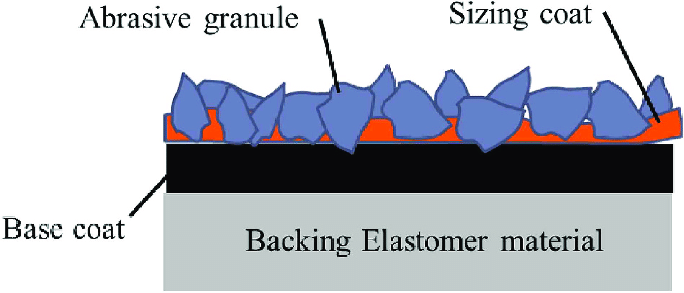These are the base materials supporting the abrasive grains. The types used are: Paper, Cloth, Vulcanized Fiber and Combination.
PAPER
The paper used in the manufacture of coated abrasives is durable, strong and ideal for light applications, both by hand and with sanding devices, since the surface of the paper provides better finishes. Three are several weights or thicknesses of paper backings, from weight A (the lightest) to weight E (the heaviest). For wet applications, waterproof papers are used. These papers are impregnated with different types of synthetic elastomers that enhance important properties of the paper such as wet strength, pliability and resistance to moisture. Light papers are coated with fine abrasive grains, adequate for a final finish of the materials. Those of intermediate weight are covered with coarser grains, adequate for intermediate sanding operations. The heavy or cylinder papers are coated with the entire range of abrasive grains and are recommended for manual or stationary sanding equipment. The principal difference between the light and the heavy paper is strength: heavy paper has a lengthwise tensile strength almost twice that of light or intermediate papers.
Paper backings in use are:
“A” wt. 70 grams per square meter (g.s.m.) – is a light and flexible paper used by hand. Hand operation allows the operator to follow intricate curves
“feet” the surface imperfections during sanding.
“C” wt. 120 g.s.m. is a slightly heavier hand sheet than “A” wt. and is a more effective backing for the coarser grades.
“D” wt 150 g.s.m., heavier than the “C” wt., stronger but still basically a hand sheet, used on the coarser grades – P80 and coarser.
“E” wt. 220 g.s.m. is stronger and less flexible than the “A”, “C”, or “D” wts. Is used mainly on machine sanding applications. Has high resistance to
tearing.
“F” wt. 300 g.s.m. has a higher tensile strength than “E” wt., higher tear resistance, applications are similar.
CLOTH
The cloths used are cotton, polyester and polyester blends, processed to obtain a suitable coated abrasives backing. These backings have special characteristics as weight, tensile strength and flexibility. “J” or jeans cloth is lighter and more flexible, while “X” is stronger and used in the manufacturing of coated abrasives to work under medium and heavy duty pressures. “W” cloth is waterproof, strong and flexible, adequate to work on wet conditions or with water containing lubricants. Polyester and their blends are higher tensile strength. Presently two types of backing are used, the “X” weight for intermediate pressure, and “Y” weight for heavy duty with high stock removal. Also recommended for wet or dry applications.
Cloth backing in use are:
“J” wt. Jeans Cloth – is made in varying degrees of flexibility – from
super flexible to flexible. Jeans Cloths are used in finishing
operations and/or where contour sanding is necessary.
“X” wt Drills Cloth – is a heavier, less flexible and stronger backing than the Jeans Cloth. Used in heavy and medium grinding applications where
Flexibility is not important.
“S” Sateens is a Drills Cloth that is stretch resistant for use on sectional
belts – belts wider than 1300 mm (51 ½).
FIBER
The fiber consists of vulcanized layers of cotton cellulose, resulting in a hard, strong and flexible backing with more body than any other. The vulcanized fibre backings are used in disc form for heavy-duty portable sanders.
Available in number of thicknesses such as:
1. 20 mil (.020″) 0.508mm – Roll
2. 25 mil (.025″) 0.625mm – Disc
3. 30 mil (.030″) 0.762mm – Disc
Main use for this product is in disc form.
COMBINATION
This type of backing is manufactured laminating high tensile strength paper and light cloth. It is coated with coarse abrasive grains and used in high-speed drum sanders for severe sanding and floor finishes.
There are many types of combined backings – such as:
1. “E” wt. paper combined with Print Cloth (similar to a cheese-cloth). This combination provides a backing with little stretch, high tensile
strength in all directions; however, lacks flexibility.
Used mainly in material manufactured for floor-sanding.
2. “F” wt. paper combined with Print Cloth – backing is stronger than the “E” wt. combined with Print Cloth, however, exhibits other similar characteristics. Can be used on drum sanding and sectional belts.
3. Drills Cloth (Sateens) combined with “E” wt. paper – extremely heavy backing designed for sectional belts in industries where heavy and
continuous stock removal is required – such as particleboard – industry.
Product resists stretch, tearing, puncturing and creasing.
4. 20 mil Fiber combined with Drills Cloth – this combination is used by some manufacturers instead of the 30 mil fiber on products used mainly in disc form. The 30 mil fiber is preferred.
GENERAL COMMENTS ON BACKINGS
Most backings are affected by atmospheric changes that can have marked affect on the performance of the finished product. Thus coated abrasives should be stored properly. (See Storage ).
When a backing absorbs moisture it generally lacks body and when moisture is lost the backing becomes dry and brittle.
Absorption and rejection of moisture can also bring about dimensional changes in the finished product.
A round fiber disc can be oval in shape as a result of gain or loss of moisture in the backing.
In choosing the correct coated abrasive for the application, the correct backing is most important.

